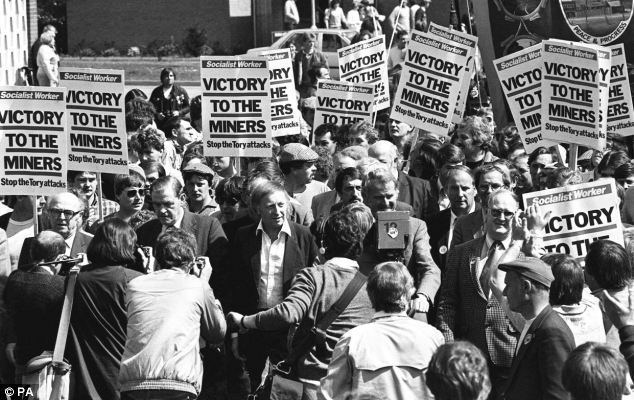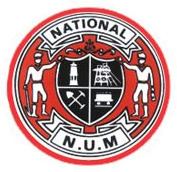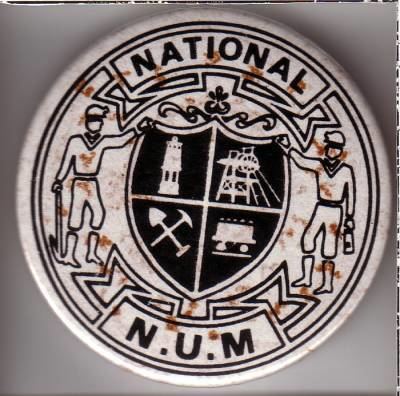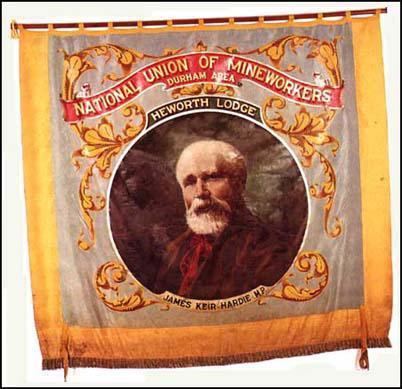Founded January 1945 (1945-01) Affiliation TUC, Labour, NSSN | Members 100 (2015) | |
 | ||
Office location 2 Huddersfield Road, Barnsley | ||
The National Union of Mineworkers (NUM) is a trade union for coal miners in Great Britain, formed in 1945 from the Miners' Federation of Great Britain (MFGB). The NUM took part in three national miners' strikes, in 1972, 1974 and 1984–85. After the 1984–85 strike and the subsequent closure of most of Britain's coal mines, it became a much smaller union. It had around 170,000 members when Arthur Scargill first led the union, a figure which had fallen in 2015 to an active membership of around 100.
Contents

Origins

The Miners' Federation of Great Britain was established in Newport, Monmouthshire in 1888 but did not function as a unified, centralised trade union for all miners. Instead the federation represented and co-ordinated the affairs of the existing local and regional miners' unions whose associations remained largely autonomous. The South Wales Miners' Federation, founded in 1898, joined the MFGB in 1899, while the Northumberland Miners' Association and the Durham Miners' Association joined in 1907 and 1908, respectively.
Post-1945

In January 1945 the MFGB was superseded by the National Union of Mineworkers. Within the organisation, each coalfield continued to exercise a degree of autonomy, having its own district association, president, general secretary, and headquarters. Originally, a national strike required a two-thirds majority in a ballot of members but proved near impossible to achieve and the majority was reduced to 55% in 1970 and to 50% in 1984. Regions of the union could call their own strikes. Different areas varied as to how militant they were and it was not uncommon for animosity to exist between areas.

The NUM was strongly supportive of the Labour Party. During the two governments of Harold Wilson, hundreds of pits closed and thousands of miners left the coal industry but the NUM leadership put up little resistance to the programme. Unofficial strikes were common in the coal industry. Following an unofficial strike in 1969 about the pay of surface workers, it was decided that the threshold for the ballot should be lowered.
The Miners' Strike, 1984–85

In the 1980s, because many coal mines were unprofitable, the Conservative government headed by Margaret Thatcher sought to close them and privatise the rest. In some areas, the NUM was militant and threatened strikes in 1981 when the government raised the issue, but as the government was not ready for a confrontation, it negotiated a settlement with the union and backed down from the closures. In what the NUM considered a confrontational move, Ian MacGregor, who had overseen cutbacks and closures at British Steel Corporation, was appointed head of the National Coal Board by Thatcher in 1983.

In 1984, after secretly stockpiling coal at power stations, the NCB announced the closure of 20 pits. Local regions organised strikes but NUM President Arthur Scargill, without a national ballot of the union's membership, declared a national strike in March 1984 which was ruled illegal in England, making striking miners ineligible for benefits. Support for the strike was not universal; in some areas such as North Wales support was small but great in others such as South Wales. Also, Yorkshire was more enthusiastic about the strike than Nottinghamshire where many miners refused to strike.
Margaret Thatcher described the strikers as the "enemy within", but Scargill was equally confrontational. Picket lines were stationed outside the pits and other industrial sites requiring coal and violent clashes with police were common. Strikers had no source of income and some were forced by circumstances to cross the picket lines as reluctant "scabs". The strike ended on 3 March 1985 and the miners returned to work without agreement with the NCB. The strike was unsuccessful and its failure was an era-defining moment in British politics. After the strike large numbers of collieries were closed.
The strike's effectiveness was reduced because the NUM leaders refused to nationally ballot members on strike action and argued that it was an issue for each area to decide. In some areas that held ballots the majority voted against striking but were subject to picketing from areas that had declared a strike. The strike was deemed illegal by the courts on the basis that the NUM rulebook required a secret ballot for a national strike. Although working miners had instigated the legal action, the NUM leadership presented it as an attack on its right to conduct its own internal affairs. The lack of a ballot reduced public support and made it possible for the government to use legal and police powers against the union without political consequences.
The closed shop in the state-owned coal sector was ended when a breakaway union, the Union of Democratic Mineworkers, was formed mostly by miners in Nottinghamshire and South Derbyshire who felt betrayed by the NUM for insisting on a strike after their area ballot had rejected strike action. In contrast, the Leicestershire area stayed in the NUM, as the area leader Jack Jones had kept good relations with the local miners by openly defying Scargill.
After the end of the strike, the NUM took an active leadership role in working to align the labour movement in the UK more closely with LGBT rights issues. Following the Lesbians and Gays Support the Miners campaign of 1984-85, the organization's Welsh chapters became the first non-LGBT organization to participate in London's Lesbian and Gay Pride parade, and at the Labour Party's 1985 policy conference, the NUM's unanimous block voting support contributed to the successful passage of Composite 26, a resolution which formally committed the party to an LGBT rights platform.
Decline
Although weakened by the strike, the NUM was still a significant force into the early 1990s. A major scheme of closures of deep mines was announced by the government in 1992. The NUM ran a national ballot on possible strike action, and this was passed by members. It worked with the National Association of Colliery Overmen, Deputies and Shotfirers to challenge the closures in the High Court; the court imposed an emergency injunction against the closures and the strike action was called off. However, from mid-1993, the mines started closing; the number of working miners and therefore also the membership of the union continued to fall.
In 2011 the union had 1,855 members. In 2012 the union's general secretary, Chris Kitchen, admitted it was in decline after the investigative website Exaro revealed that in 2011 the Derbyshire branch had just one member who was not a paid official. Filings with the Trades Union Certification Officer showed that the NUM's Derbyshire branch had just four members, three of whom were paid officials.
In 2012 it emerged in court cases between the NUM and its former president Arthur Scargill that a substantial proportion of union members' subscriptions was being spent on expenses for Scargill, including unauthorised rent payments for a flat in London's Barbican Estate.
A further 540 miners' job losses were announced in January 2013.
Areas
As of 2016, the following area unions are affiliated to the NUM:
